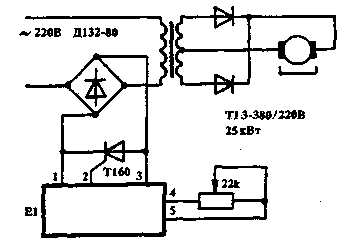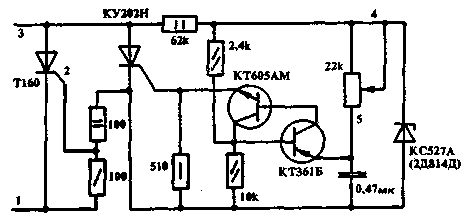Powerful regulator. Encyclopedia of radio electronics and electrical engineering

Encyclopedia of radio electronics and electrical engineering / Regulators of current, voltage, power
 Comments on the article
Comments on the article
The main advantage of this regulator - simplicity and reliability. The scope of its application is quite extensive - from powering powerful electric drives to welding machines. The circuit is not afraid of short circuits in the secondary circuit.

Ris.1
If the regulator is supposed to be used with an active load (electric heating, appliances, incandescent lamps), then Tr1 can be excluded from the circuit. On fig. 1 shows the power part of the circuit, and in fig. 2 - electronic control unit connected to a powerful thyristor through contacts 1-3. Through pins 4-5, the regulator potentiometer is connected to the external control panel.

Ris.2
Author: A.M., Slavyansk; Publication: N. Bolshakov, rf.atnn.ru
 See other articles Section Regulators of current, voltage, power.
See other articles Section Regulators of current, voltage, power.
 Read and write useful comments on this article.
Read and write useful comments on this article.
<< Back
 Latest news of science and technology, new electronics:
Latest news of science and technology, new electronics:
Machine for thinning flowers in gardens
02.05.2024
In modern agriculture, technological progress is developing aimed at increasing the efficiency of plant care processes. The innovative Florix flower thinning machine was presented in Italy, designed to optimize the harvesting stage. This tool is equipped with mobile arms, allowing it to be easily adapted to the needs of the garden. The operator can adjust the speed of the thin wires by controlling them from the tractor cab using a joystick. This approach significantly increases the efficiency of the flower thinning process, providing the possibility of individual adjustment to the specific conditions of the garden, as well as the variety and type of fruit grown in it. After testing the Florix machine for two years on various types of fruit, the results were very encouraging. Farmers such as Filiberto Montanari, who has used a Florix machine for several years, have reported a significant reduction in the time and labor required to thin flowers.
... >>
Advanced Infrared Microscope
02.05.2024
Microscopes play an important role in scientific research, allowing scientists to delve into structures and processes invisible to the eye. However, various microscopy methods have their limitations, and among them was the limitation of resolution when using the infrared range. But the latest achievements of Japanese researchers from the University of Tokyo open up new prospects for studying the microworld. Scientists from the University of Tokyo have unveiled a new microscope that will revolutionize the capabilities of infrared microscopy. This advanced instrument allows you to see the internal structures of living bacteria with amazing clarity on the nanometer scale. Typically, mid-infrared microscopes are limited by low resolution, but the latest development from Japanese researchers overcomes these limitations. According to scientists, the developed microscope allows creating images with a resolution of up to 120 nanometers, which is 30 times higher than the resolution of traditional microscopes. ... >>
Air trap for insects
01.05.2024
Agriculture is one of the key sectors of the economy, and pest control is an integral part of this process. A team of scientists from the Indian Council of Agricultural Research-Central Potato Research Institute (ICAR-CPRI), Shimla, has come up with an innovative solution to this problem - a wind-powered insect air trap. This device addresses the shortcomings of traditional pest control methods by providing real-time insect population data. The trap is powered entirely by wind energy, making it an environmentally friendly solution that requires no power. Its unique design allows monitoring of both harmful and beneficial insects, providing a complete overview of the population in any agricultural area. “By assessing target pests at the right time, we can take necessary measures to control both pests and diseases,” says Kapil ... >>
 Random news from the Archive Random news from the Archive Heat resistant memory for interplanetary missions
28.07.2019
Studies of the two planets closest to the Sun, Mercury and Venus, have always been complicated by the fact that the conditions on their surfaces are extremely unfavorable. For example, Mercury can heat up to 430 ° C, and Venus, due to the characteristics of the atmosphere, even more. Therefore, any apparatus that studies these celestial bodies up close must be prepared accordingly.
Modern electronics are very sensitive to heat, and temperatures of hundreds of degrees Celsius are detrimental to them. However, scientists have been trying to solve this problem for many years and it seems that they have achieved some success. For example, Arizona State University recently announced the development of next-generation electronics modules under the NASA-funded HOTTech program, on the basis of which it was possible to create memory elements that can withstand high temperatures - up to 300 ° C and even higher.
Gallium nitride was taken as the basis material for creating high-temperature electronics. The fact is that silicon, which is traditionally used to create microprocessors and memory modules, has a relatively low band gap (this indicator determines the minimum energy required for an electron to move from the valence band to the conduction band) - only 1,12 eV. At the same time, for gallium nitride, it is 3,4 eV, which allows devices to operate normally at much higher temperatures. At the same time, it is noted that this is not the only semiconductor material with a wide band gap being studied as part of the high-temperature electronics program. Another worthy candidate with a wide bandgap is silicon carbide.
The memory device was fabricated by chemical vapor deposition on a gallium nitride substrate. During testing, the memory module showed stable performance over the entire range from 25 to 300°C. When the temperature rose to 350°C, control over the processes was lost, but it was restored after the temperature dropped to room temperature. Thus, even in the case of extreme heating, the memory module itself will not be lost, although it will stop working normally for a while. At the same time, as Yuji Zhao notes, the results of the work are intermediate and the next step will be the creation of memory modules that can withstand up to 500 ° C in normal mode, and with such electronics it is already possible to explore the surface of even Venus, even Mercury.
|
 Other interesting news:
Other interesting news:
▪ TLP-T71U projector from Toshiba
▪ soft robot fish
▪ Hydrogen scooter
▪ biodegradable straw made of wood
▪ The world's fastest hard drive from Seagate
 News feed of science and technology, new electronics
News feed of science and technology, new electronics
 Interesting materials of the Free Technical Library:
Interesting materials of the Free Technical Library:
▪ section of the site Wonders of nature. Article selection
▪ article The scope of first aid for various types of disasters. Basics of safe life
▪ article What is Impressionism? Detailed answer
▪ article Alfalfa townsville. Legends, cultivation, methods of application
▪ article Making a printed circuit board at home. Encyclopedia of radio electronics and electrical engineering
▪ article A sachet moves in a bottle of water. Focus secret
 Leave your comment on this article:
Leave your comment on this article:
 All languages of this page
All languages of this page
Home page | Library | Articles | Website map | Site Reviews

www.diagram.com.ua
2000-2024







 Arabic
Arabic Bengali
Bengali Chinese
Chinese English
English French
French German
German Hebrew
Hebrew Hindi
Hindi Italian
Italian Japanese
Japanese Korean
Korean Malay
Malay Polish
Polish Portuguese
Portuguese Spanish
Spanish Turkish
Turkish Ukrainian
Ukrainian Vietnamese
Vietnamese


 Leave your comment on this article:
Leave your comment on this article: